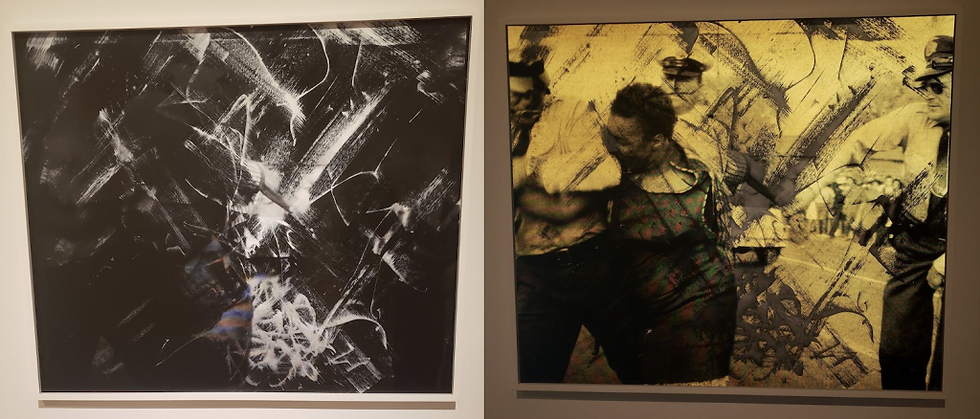Words and Images courtesy of Moriah Joy. Feature image: Titus Kaphar, Columbus Day Painting

There is the notion that art museums are grandiose images of women baring their bodies somewhere in the woods, or that one has to be of a certain pedigree or education level to fully enjoy them. However, the Virginia Museum of Contemporary Art throws all those preconceived notions out the door. Not only are pieces extremely relevant and relatable, the staff prides themselves on making art accessible to everyone. Back in May of this year, I had the pleasure of speaking with Brad Tuggle, the Director of Audience Development, about the digital offerings they had to keep the community engaged with their amazing artists even though the physical galleries were not open. This past week, I had the wonderful opportunity to speak with Truly Matthews, the Curator of Education for MOCA, after touring the exhibits. During my tour, I took photos of some of the most impactful and eye catching pieces. However, the pieces are far more intricate and textured in person than can be conveyed by photographs.

Carlos Vega, Just Discovered
One of the things that I learned in my conversation with Truly was MOCA is a non-collecting museum, meaning that any pieces that enter their doors are only there for a short period of time as they travel to different museums. Depending upon when you go and the exhibits they have on display, you may see anywhere from one to three exhibits in their main gallery space. Currently, the Shifting Gaze: A Reconstruction of the Black and Hispanic Body in Contemporary Art and New Waves 2020 (a statewide competition) are sharing the main gallery space, with Hampton Boyer’s first solo show on display in the gallery near the atrium. The reason why this was intriguing to me was because as you go through the natural path of the museum, each exhibit provokes a different reaction from the viewer.
“Art is a catalyst for conversation.”- Truly Matthews
The Shifting Gaze exhibit commands the attention of the viewer as each piece pulls you in to analyze the details and the story. This feeling is beautifully described by artist Ebony G. Patterson, who is a part of the Shifting Gaze exhibit, as the Flower and the Bee Syndrome, where the viewer (bee) is drawn to the art (flower) either because of its provocative nature or aesthetic beauty. We stay with that piece until we have drawn all the emotional needs or thoughts from it and then move onto the next one. Each piece in this show pulled on a different emotion for me. The pieces by Carlos Vega and Mickalene Thomas are eye-catching because of their sheer magnitude but really connect with themes of pride in the small pieces of who they are.

Hank Willis Thomas Turbulence (White Strokes). This work is activated by camera flash. On the left we have the work with no camera flash. On the right, a camera flash was used to take the photo.
Since Shifting Gaze has a cohesive theme to the show it makes it easier to understand the creative intention behind each piece. With the New Waves and Hampton Boyer exhibits, the viewer is drawn to the initial reaction of the pieces, but sometimes needs to rely upon the outside resources to fully grasp the intention of the piece. Truly explained that one of the areas they focus on heavily in their shows and programming is incorporating the artist’s voice so that there is no misunderstanding of their artist process. This is done in a few different ways. In the New Waves gallery, they have direct quotes on placards that are the artist statements submitted with the pieces as a part of the competition. For Hampton Boyer, there is an audio tour which he recorded for the viewer to hear him directly explain his work. During virtual programming, most of the time they try to have the artist be present during talkbacks for them to explain or discuss the social and emotional impact of the piece.

Pat Jarrett, Robert E Lee (Shrouded)
The museum offers many educational opportunities both in exploring art and being able to create your own. They have a variety of art classes offered through their studio school available for ages 6-99. Some classes offered include the Art of Storytelling, Basic Drawing Techniques, Abstract Art, Oil/ Acrylic Painting, and Photography Made Simple. For more information on these classes please visit https://virginiamoca.org/studio-school

Ebony G Patterson, He
The museum will also be re-opening the interactive portion of their gallery called Art Lab. In this section, viewers have a chance to interact with the pieces in a now contactless environment. “We weren’t sure what was going to happen with Art Lab because of COVID,” explained Truly, “so the installation took a little more time, and we had to adapt it to fit safety guidelines, but we’re super excited to finally have it open back up.” For those planning a trip soon, the Art Lab will reopen on September 3rd.
With all of the programming available, the level of social engagement and commitment to the community, as well as the beauty of the building and exhibition space, MOCA is becoming one of my new favorite places in the Hampton Roads area. Check it out for yourself and see what you can discover.
Currently, the museum entrance fee is waived due to very gracious donors, however, you do have to reserve tickets in advance to allow for proper social distancing. To schedule your free tour please visit their website. For a closer look at the exhibits and discussions with the artists check out their Instagram. Audio tours are available in both English and Spanish.

Comments